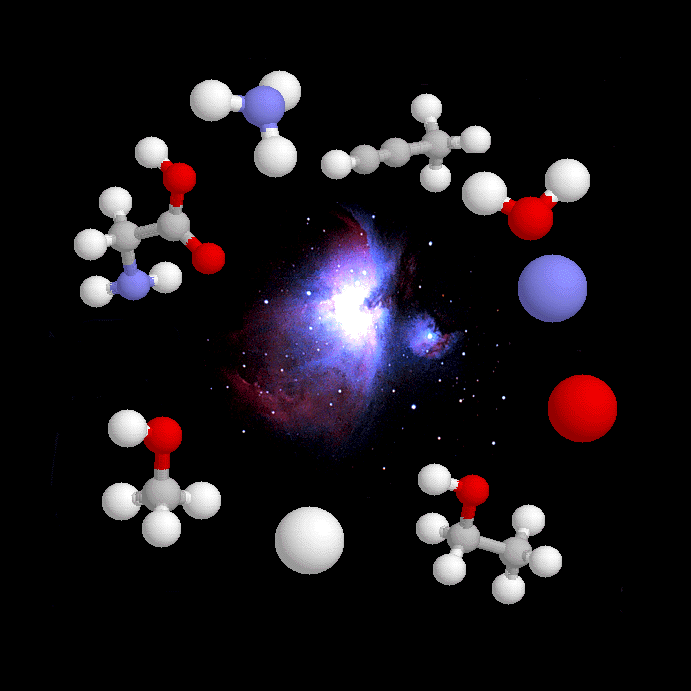

A Listing of the Most Abundant
Interstellar Elements
|
Element |
Symbol |
Atomic Number |
Relative Abundance |
| Hydrogen |
 |
1 |
10,000 |
| Helium |
 |
2 |
1,000 |
| Carbon |
 |
6 |
4 |
| Nitrogen |
 |
7 |
1 |
| Oxygen |
 |
8 |
9 |
| Neon |
 |
10 |
1 |
Sources
Data from Anders and Grevesse, 1989
Flowers, David, Molecular Collisions, 1990
A Partial Listing of Interstellar Molecules
Found in Molecular Clouds
|
Molecule |
Name |
|
H2
|
Molecular Hydrogen
|
|
CO
|
Carbon Monoxide |
|
NO
|
Nitric oxide
|
|
C2
|
Carbon Dimer
|
|
OH
|
Hydroxyl
|
|
CH
|
Methylidyne
|
|
CN
|
Cyanogen
|
|
CS
|
Carbon monosulfide
|
|
SO
|
Sulfurmonoxide
|
|
SiO
|
Silicon monoxide
|
|
SiS
|
Silicon sulfide
|
|
PN
|
Phosphorus nitride
|
|
PO
|
Phosphorus monoxide
|
|
C2H
|
Ethynyl
|
|
HCN
|
Hydrogen cyanide
|
|
HNC
|
Hydrogen isocyanide
|
|
H2O
|
Water
|
|
HDO
|
Deuterated water
|
|
HCO+
|
Formylion
|
|
N2O
|
Nitrous oxide
|
|
SO2
|
Sulfur dioxide
|
|
C3N
|
Cyanoethynyl
|
|
C3O
|
Tricarbon monoxide
|
|
NH3
|
Ammonia
|
|
CH4
|
Methane
|
|
C3H
|
Propynlidyne
|
|
H2CO
|
Formaldehyde
|
|
H2C2O
|
Ketene
|
|
CH2NH
|
Methylenimine
|
|
C4H
|
Butadiynyl
|
|
C3H2
|
Cyclopropenylidene
|
|
CH3OH
|
Methanol
|
|
CH3C2H
|
Methyl acetylene
|
|
HCOOCH3
|
Methylformate
|
|
CH3CH2OH
|
Ethanol
|
|
NH2CH2COOH
|
Glycine II
|
Sources
- All molecules with the exception of ammonia, water, and nitrous oxide
- Irvene et al. (1987)
- Hartquist, T. W., Molecular Astrophysics, 1990
- Detection of Interstellar N2O: A New Molecule Containing
an N - O Bond,
L. M. Ziurys, A. J., Apponi, J. M. Hollis, and L. E. Snyder,
Ap. J. (Letters), 436, L181 (1994).
Note: This is only a partial listing of molecules detected
in the cold confines of interstellar space. The majority of the
compounds in the list have been detected using radio telescopes tuned
to the faint glow of the rotational spectra of the molecule. The
12 meter radio telescope at the National Radio Astronomy Observatory
Arizona Operations is currently being used to detect the mm wavelengths
of interstellar molecules. A Millimeter Array will soon be constructed
at the Arizona Site to facilitate in the discovery and
identification of molecules in space.
Return to Home Page
Last modified: July 12, 2000
by Jeff Mirick



